More and more Filipinos are going hungry. This is according to the Rapid Nutrition Assessment Survey conducted by the Food and Nutrition Research Institute (FNRI) late last year. After surveying almost 6,000 households all over the country, FNRI reported that 62.1% of families experienced moderate to severe food insecurity.
When does a household qualify as being “food insecure”? The FNRI gives the following criteria:
- Worrying about food
- Inability to eat preferred foods
- Only able to eat a few kinds of foods
- Eating foods they do not desire
- Eating smaller portions
- Eating fewer meals daily
- Absence of food in the household
- Going to sleep hungry
- Going through a whole day without sustenance
The COVID-19 pandemic seems to be the cause of this hunger spike. FNRI states that more than half of surveyed households reported having less access to food during community quarantine because of: 1) lack of money, 2) limited public transportation, 3) job loss, 4) limited food stores in their area, and 5) being an elderly with no family members to help them buy food.
But food security may be achieved through one’s own efforts. Last year, FNRI posted a call for Filipinos to grow their own food during the pandemic. This way, households are assured of food supply despite limited mobility. This is especially true in urban areas, which are “less likely to consume fresh produce, which are good sources of vitamins and minerals that boost immunity.
 Kangkong harvest (photo by Chie Roman)
Kangkong harvest (photo by Chie Roman)
Being a Farmer in Your Own Backyard
The terms “plantito” and “plantita” became popular during the lockdown as Filipinos turned to gardening to care for their mental health. The challenge now is to shift the focus from greens that beautify the home to edible plants.
According to PAGASA, the hot and dry season this 2021 would be shorter than the previous years’. This may be considered good news because in a Panahon TV interview, Agriculturist Lito Bollosa from the Bureau of Plant Industry said that both the onset and end of the rainy season is the most ideal time to plant.
However, one can still start planting during the hot and dry season. “When it comes to vegetables, we can plant the ingredients of the pakbet. These are indigenous crops that can survive adverse conditions and the constant changes in weather,” Bollosa explained in Filipino.
Bollosa states that crops which require minimal supervision and water include:
- talong
- kamatis
- sili
- gabi
- ube
- kamote
- kamoteng kahoy
- mani
- munggo
- soybeans
Aside from being low maintenance, these crops are also easy to plant. “With indigenous vegetables like alugbati, kangkong, and kamote, you only need to stick the cuttings into the soil. With just a little water, they can already survive,” said Bollosa. He added that other crops that are able to survive intense heat include mung beans, corn—and dragon fruit, which belongs to the cactus family and therefore doesn’t require a lot of water.
Meanwhile, fruits that take center stage this hot season are watermelon and mangoes. “We see an increased production of fruits and vegetables now because of the sun’s constant presence. These crops need sunlight to produce their own food. The excess nutrients end up as fruits.”
However, extreme weather conditions may also cause plants to flourish. This is because of their need for survival, causing them to release more antioxidants and other protective chemicals. “Prolonged heat or rains can cause plant stress,” shared Bollosa. “For example, when the calamansi experiences excess heat or rains, it tends to produce more flowers and fruits.” This technique is used in farming to boost fruit production. Bollosa elaborated, “Fruits like rambutan, lanzones, and avocado flower during the hot season. After the ‘ber’ months, they are subjected to heat to induce flowering.”
 According to Bollosa, calamani produces more fruit when stressed. (photo by Chie Roman)
According to Bollosa, calamani produces more fruit when stressed. (photo by Chie Roman)
Planting Tips
Before planting your own food, Bollosa suggests these tips:
- Research if the plant you want to grow is compatible with your location. Climate plays an important role in agriculture. Highland crops flourish in cold weather, while lowland crops can stand the literal heat with the help of technology.
- Plant in the right soil. “Start with a soil mixture,” advised Bollosa. “You can mix carbonized rice hull or charcoal to boost its carbon content. This allows your soil to absorb more moisture.”
- Use a planting pit. A planting pit is filled with organic materials such as dried leaves, grain stalks and other vegetative material that enriches the soil. The pit is dug close to crops to increase soil fertility and moisture retention.
- DIY the process. In urban areas wherein planting is confined to small spaces, Bollosa suggests using downscaled agricultural practices. Examples are covering pots with newspaper or cardboard to prevent water evaporation; and punching holes in plastic bottles so they can irrigate crops without drowning the soil.
 Growing young ginger (photo by Chie Sales)
Growing young ginger (photo by Chie Sales)
Following the Planting Calendar
To be able to successfully grow food, Bollosa stressed the importance of following the planting calendar. Certain plants grow their best in specific months of the year. The Department of Agriculture released a comprehensive planting calendar, which Panahon TV condensed below:
| All Seasons | End of Rainy season to Cool and Dry Season |
ampalaya | upo |
Bataw | broccoli |
| kangkong | Chinese cabbage |
lettuce | labanos |
mustasa | patani |
okra | muskmelon |
| pechay | potato |
| sitaw | squash |
By following nature’s rhythm, you can reap the benefits of growing your food. Aside from getting the nutrients your immune system needs, you are ensured of your food’s safety and quality. Planting can also help you save money, protect the environment, and boost your household’s food security. You can enjoy all these rewards, while taking part in one of the greatest miracles—nurturing another life besides your own.
Watch Panahon TV’s interview with Lito Bollosa here.
More than a year into the pandemic, being in quarantine and following protocols have become our way of life. Our own homes have turned into a hub for all our main activities—work, school, and even buying goods, thanks to the internet. Limited movement is vital in preventing sickness, but the feelings of uncertainty, boredom, and powerlessness may affect mental health. However, maintaining our health and well-being is a must during these times.

Importance of health and wellness
More than ever, health and wellness must be prioritized as this serves as our shield against illnesses. According to UP (University of the Philippines Diliman) College of Human Kinetics Faculty Member Hercules Callanta, “The ability to fight off whatever viral load … is dependent on the immune system, where the immune system will fend off the attacks of a viral infection. Some people, even if [they] were exposed to someone in the same household who had a viral problem do not get sick or don’t even become positive because their immune system, which is the reflection of their health and wellness, was able to fend it off.”
With gyms and fitness centers still closed in NCR Plus due to the Modified Enhanced Community Quarantine (MECQ), some have turned to home-based workouts to stay healthy. This is a commendable thing since according to Callanta, exercise and the immune system are linked. “If you are fit and healthy, active and exercising well, researchers have shown that the immune system, due to the chronic effects of exercise, can become a lot stronger and more equipped to fend off infections.”
Maintaining our health and well-being during the pandemic
Callanta stressed that the World Health Organization (WHO) also recognizes the importance of exercise, not only for our physical health, but also for our mental and emotional well-being. He gives these tips:
- Eat right. Callanta advised following the Pinggang Pinoy. In this serving, half of the plate should be fruits and vegetables, while the other half should be composed of carbohydrates and protein. Carbohydrates include whole grains and whole wheat, while protein examples are fish, eggs, poultry and beef. “Proper food intake is a must since it’s a basic essential of our life,” said Callanta, adding that since there is no medication for COVID-19, we must rely on eating healthy foods to boost our immune system.
- Get enough rest and sleep. Though 7 to 8 hours of sleep is recommended, the quality of sleep is also important. Before going to bed, take time to relax the body and mind through gentle stretching and meditation. Make sleeping a habit by going to bed at the same time every night, and waking up roughly at the same time every morning.
- Manage stress. Stress is unavoidable, but can be managed through regular exercise. Other stress management techniques include remaining calm, talking to people, limiting news feeds and establishing routine.
- Engage in exercise and physical activity. “WHO says that 150 to 300 minutes of moderate to vigorous physical activity every single week has to be maintained.” Callanta recommended doing Short Incidental Physical Activities (SIPA)—functional exercises that can be done in small spaces easily available to us. “For every hour of uninterrupted sitting, we must stand up and do movements—not necessarily workouts but movements for 2 to 4 minutes,” said Callanta. This already contributes significantly to our health and wellness.
SIPA workouts
Those who work and study from home can benefit from SIPA. Callanta stated that this is “a way for us to maintain our health and fitness despite the quarantine and movement restrictions.” Examples of SIPA include:
- Squats
- Airwalk
- Arm and Leg raise
- Hinged stretch
- Twist
- Combination of twisting, bending and squats
- Step back lunges
- Marching
- Flying
- Knee touches
- Push ups
- Pull ups
Each exercise can be done for 2 to 4 minutes, which Callanta demonstrated through this video:
How exercise boosts mental health
According to the Department of Health, there are 3.6 million Filipinos suffering from mental disorders amidst the COVID-19 pandemic. The lack of mobility and distraction can cause us to overthink things. The lack of motivation may also push us to forego exercise, which Callanta advised against. “Through chronic exercise, our endocrine system secretes several hormones. Some of them are good hormones which allows us to feel good, serving as de-stressors.” There are also hormones that give us pain tolerance against factors that cause pain and stiffness.
Maintaining our health is an important responsibility with or without the pandemic, but it’s even more vital now because our life is at stake. Taking care of our overall health is our best investment, not only during the pandemic, but throughout the course of our lifetime.
 Chie Roman describes herself as a “rookie pickler”.
Chie Roman describes herself as a “rookie pickler”.
 Annette Ferrer is a self-confessed “food nerd”.
Annette Ferrer is a self-confessed “food nerd”.
At the start of the Luzon-wide community quarantine last March brought about the COVID-19 pandemic, rumors of the government implementing a total lockdown surfaced. In response, many Filipinos flocked to wet markets and grocery stores to secure their food supply. The result? Long and snaking lines of buyers, as well as cleaned-out shelves and stalls as food deliveries from companies and the provinces were delayed by stringent checkpoints.
But the very act of going out to contend with the panic-buying crowd was already a great risk, potentially exposing more people to the deadly virus. The key then was to limit the movement of household members—something that Chie Roman, a mom, found essential since her family shared their apartment building with many other households, including her brother and his family, and even a three-month old. One of the solutions she came up with was pickling.
“My husband and I made it a goal to eat vegetables or fruits every day,” she says. “We couldn’t possibly eat canned food all throughout the ECQ (Enhanced Community Quarantine), so we decided to make pickled vegetables.” Chie’s husband took advantage of his twice-a-month trip to the grocery store or wet market by buying a lot of vegetables, which Chie either froze or pickled. “It’s a good life skill for the kids to learn,” she adds. “It teaches them that food doesn’t always come from the sup.
For Annette Ferrer, a self-confessed “food nerd”, pickling is a natural outlet for her culinary passion. “In my twenties, I taught myself how to cook because I planned on living on my own. Fermentation, dehydration, and all my other kitchen pursuits flow from that desire to be independent and self-sufficient. Very early in the lockdown, I felt very lucky and amazed to have been cultivating this passion for food because now is the time that it will really become handy—a survival tool, not only for the body, but also for the mind.”
Pickling 101
Pickling has been around for thousands of years, likely originating in India, where evidence of pickled cucumbers and mangoes dating back to 2400 BC has been discovered. The method was used to preserve food, and to give it added texture and flavor. Pickling usually involves brine (salt and water solution) or vinegar. While vinegar prevents the growth of bacteria that spoils food, brine prevents spoilage due to oxygen exposure. After a few days, the brine acidifies with the help of good bacteria.
In the Philippines, traditional fermentation in earthen jars has led to a variety of well-loved fare, such as bagoong (fermented shrimp paste), lambanog (palm liquor) and atsara (fermented green papaya, carrots and shallots). To make pickled foods more flavorful, the fermenting liquid is usually seasoned with garlic, ginger, red onions and peppers.
Pickling journey
Chie has always dabbled with making kimchi, but only regularly pickled vegetables during the quarantine. Aside from ampalaya (bitter gourd) and young ginger, her family’s favorite is pickled singkamas (turnip). “My first batch of pickled singkamas turned out better than I expected,” she recalls. “It was crunchy, salty and sweet at the same time. I put a sliver of ginger in each jar. We pair it with anything inihaw (grilled) or fried, but it can also be eaten as a snack.”
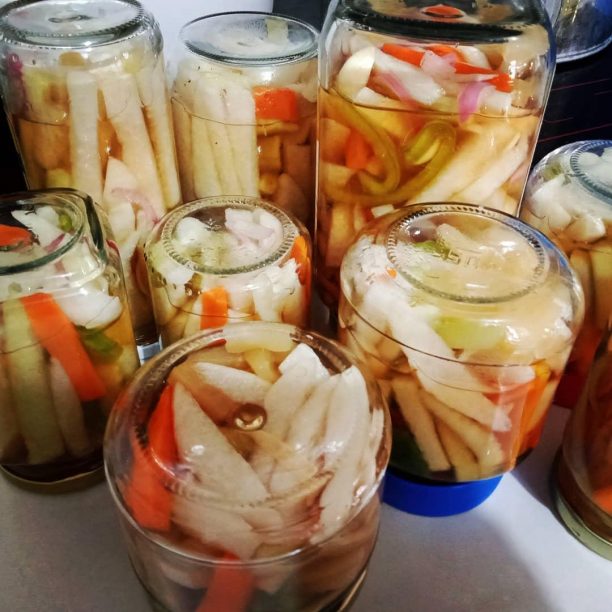 Pickled singkamas
Pickled singkamas
Meanwhile, Annette’s adventurous palate spurred her on to make variations of kimchi—from the usual cabbage to the more unusual combos of apple-radish and kalabasa-sayote (squash-chayote). “Apple-radish kimchi is my favorite! It’s crunchy and sweet. The kalabasa-sayote is creamy and has a nice bite to it.” She also loves fermenting chilis, spicing them with ginger and turmeric, and the more exotic cinnamon and cardamom. “The chilis are great as a sauce. I don’t need to buy hot sauce anymore. After blending and straining my chili sauces, I fry up the pulp and make another sauce—like the chili-garlic you put on siomai, but with a different flavor. The last one I made had apples and raisins in it.”
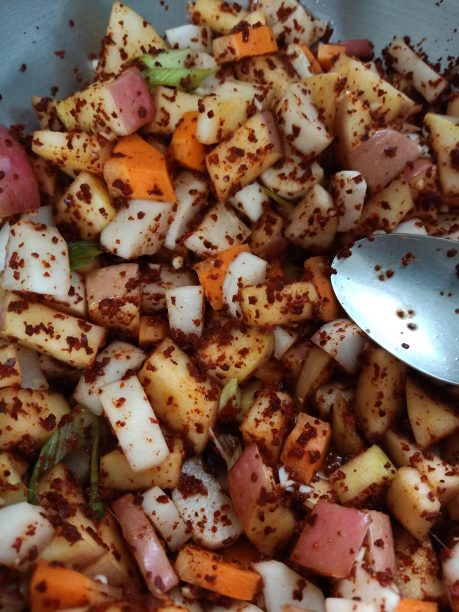 Apple-radish-carrot kimchi
Apple-radish-carrot kimchi
Pickling in the time of a pandemic
Life during a pandemic is rife with uncertainties. For Chie and Annette, pickling is part of the new normal of being self-reliant and thrifty. Chie explains, “We’ve been able to save money and cut down on waste. The vegetable peels, seeds and scraps, we either put in the compost bin or plant in containers.”
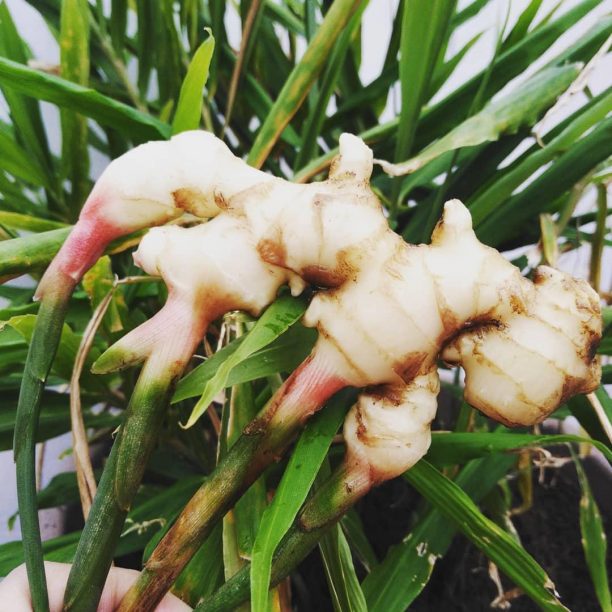 Chie’s ginger harvest
Chie’s ginger harvest
Though Annette is fully aware of how fermentation is an economical and practical means of preserving food, the process also fulfills her on various levels. “It is creative, intellectual, manual, but also nourishing, and a part of resistance and independence. If we only know how to buy our food, we are only consumers in the capitalist system—and there is only ‘one taste’ to things such as sinigang, kare-kare, pancit canton because we eat them from commercial spice mixes. But by making our own food, we are more in touch with our history and culture. Sandor Katz, a fermentation revivalist, says that fermenting is resistance to the idea that bacteria is bad, that everything should be sterile. Fermentation gets us in touch with worlds that are not just ours—the world of yeasts and bacteria.”
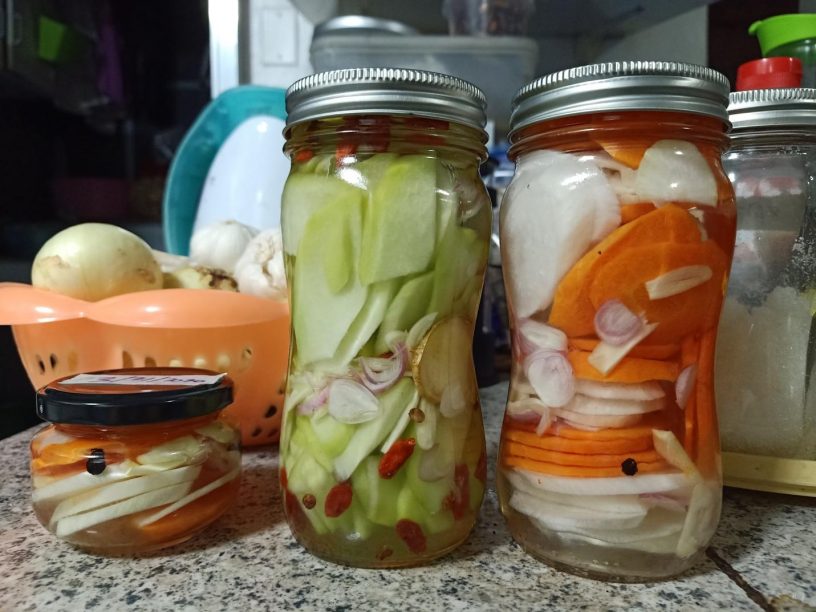 Annette pickles sayote ang goji berry (center); singkamas and carrot (right)
Annette pickles sayote ang goji berry (center); singkamas and carrot (right)
Never-ending gastronomical journey
Both women’s forays into food preparation don’t end with pickling. Chie’s roof deck has become a haven for her container gardens of herbs and vegetables. She also makes homemade yogurt, her family’s source of probiotics that promote digestive health.

Chie dries her basil
Annette has taken on making her own vinegar from fruits such as pineapple, banana, orange and jackfruit. Recently, she’d bought a dehydrator and has since been making dried fruits. “They’re like candy! During the ECQ, we would go to the market once every two weeks. Sometimes, we try to stretch it to three weeks. So you can imagine how the fruits needed to be consumed first. By week two or three, we don’t have any more.”
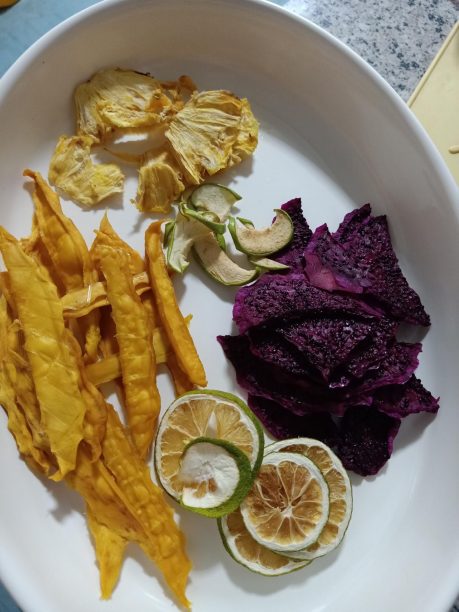 (clockwise) Annette’s dried mango; pineapple; apple; dragonfruit; dayap
(clockwise) Annette’s dried mango; pineapple; apple; dragonfruit; dayap
As for those who want to try pickling, Chie advises, “The most important tip is to make sure you pick the freshest vegetables. Different vinegars yield different tastes. I’ve used rice wine vinegar, apple cider and good old cane vinegar. I still have lot to learn. I am a rookie pickler and Google is my friend.”
Annette encourages beginners to follow their palate. “Start with something you like to eat— if it is kimchi or vinegar, or pickles, or hot sauce! That first success is so encouraging, so aim for simple projects first, then expand.”
4 cloves garlic, minced Half inch ginger, chopped 1 large Fuji apple or 2 small, chopped into 3/4 inch cubes 1 large daikon radish, chopped into 3/4 inch cubes 1 medium carrot, chopped into 3/4 inch cubes 1 bunch spring onions, sliced into 1.5-inch length 1 heaping tablespoon of rock or sea salt Fish sauce to taste 1-4 tablespoons gojugaru or Korean red pepper flakes
- In a large bowl, combine the apple, carrot, radish, salt, garlic, and ginger. Let it sit for about 15 minutes.
- Mix ingredients to check if they have released their juices. Add fish sauce and more salt if necessary.
- Add in 1-4 tablespoons of gojugaru or to taste, depending on how spicy you like it.
- Add in spring onions and stir everything to combine well.
- Transfer the fresh kimchi into a clean glass jar with a non-metallic lid. With a large spoon or with your fist, pack down the kimchi so that the vegetables are submerged in their own juices. Leave about an inch of space at the top of the container for fermentation.
- Cover with the lid and set aside at room temperature overnight or for 2-3 days, depending on how sour you want your kimchi to be.
- When the kimchi has arrived at the level our sourness you enjoy, transfer into the fridge to slow down the fermentation process.
Christmas is a season of love and happiness— the time of year filled with joyful melodies, countless parties and family reunions.
However, this is also the season of fire hazards, which come in the form of lavish displays that make use of substandard Christmas lights.
Last year, the Bureau of Fire Protection (BFP) documented a total of 1,079 fire incidents during the “ber” months in National Capital Region alone and 4,029 fire cases in the whole country. Based on the data, most of the fire incidents happened during the month of December.
That’s why this Yuletide Season, it’s important to prioritize your family’s safety with these tips:
Look for the ICC mark. When buying decorations such as Christmas lights and lanterns, the Department of Trade and Industry (DTI) suggests buying only those with ICC marks, which are printed on stickers. The ICC or the Import Commodity Clearance is obtained through the Product Certification Scheme of the Bureau of Product Standard (BPS) under the governance of DTI. ICC marks validate that the products have met the requirements of the Philippine National Standard (PNS) specified by the BPS.
ICC marks must bear the unique serial number of the product shipment and the name of its manufacturer or importer. This way, you can easily trace the product’s source.
For consumer complaints and queries, call DTI Direct at 7513330 or 0917-8343330.
Inspect your Christmas lights thoroughly before use. Check the cord and plug for any damage. If you plan to use your old Christmas lights, watch out for exposed live wires, melting or opening in the lamp holders, and loosely screwed light bulbs.
Read the instructions carefully. Make sure you follow voltage requirements and warnings such as the following: For indoor use only; Disconnect from supply before removing or inserting any lamp; Do not overload electrical outlets; and Avoid damage to insulation. Do not attach more than the recommended sets of Christmas lights. Normally, only three sets are allowed to avoid overloading.
Keep lights away from combustible materials. If you’re buying ordinary Christmas lights sans safety features, the BFP says its best to keep them away from curtains and other flammable items. The bulbs of this type of Christmas lights easily overheat, which may cause fire. It also helps to position appliances such as your television, computer, sound system and heating devices like your microwave oven in a spacious area to prevent overheating.
Let your lights cool down. Avoid leaving Christmas lights turned on overnight to avoid overheating. This will also help keep your electricity bill from ballooning.
Follow the safety rules. Never place electrical cords under a carpet to prevent someone from stepping on them. Unplug appliances by grasping the plug, not by yanking the cord, to prevent damage. Do not leave infants or children near electrical outlets. Their curiosity may lead to accidents, including fire.
Aside from safety, health is also important to keep in mind this festive season. At this time, social gatherings are inevitable, as well as indulging in food and drink.
Data gathered from the 2006 Philippine Health Statistics showed that Non-Communicable Diseases (NCDs) are among the leading causes of death in the country. Cardiovascular disease, cancers, chronic obstructive pulmonary diseases and diabetes mellitus are the four major NCDs acquired through an unhealthy lifestyle.
According to the National Nutrition Survey conducted by the Food and Nutrition Research Institute, hypertension cases have increased to 25% from 22% from 2003 to 2008, with diabetic cases increasing from 3.4% to 4.8% The study also revealed an increase in the consumption of food high in fats and sugars and the lack of physical activity among the entire adult population.
To ensure that we enjoy a disease-free Christmas, the Department of Health (DOH) reminds us to take note of the following:
Prepare early. Overfatigue and stress due to rushing and preparing for the holidays may cause health complications such as heart disease and hypertension. Get enough sleep so that the mind and body can rest.
Give safe and age-appropriate toys to children. Choose toys without small and sharp parts, which may cause choking and injury among children. Read and follow instructions carefully.
Prepare well-balanced holiday meals. Aside from rich holiday foods such as ham, lechon, queso de bola and sweets, make sure that your dining table is also loaded with fruits and vegetables. Ensure cleanliness and freshness of foods to avoid food poisoning.
Eat healthy. Eat nutritious foods to sustain your daily activities. Salty and fatty foods are prevalent this season so remember to only eat them on moderation.
Drink plenty of liquids, such as water and fruit juices, to facilitate excretion.
Avoid too much alcohol. Do not drink and drive; we all know how drunk driving results to vehicular accidents. Too much alcohol can cause serious damage to the liver and heart, and may induce strokes.
Guard yourself against sickness. During this season, we’re more susceptible to coughs, colds, and fever. If these symptoms persist for more than five days, consult your doctor.
Greeting everyone a Merry Christmas has become a standard this season, but to truly achieve merriment, remember that health and safety should come first. Here’s to a fire-free, heart-healthy Christmas to everyone!
Sources: BFP | DOH | DTI

